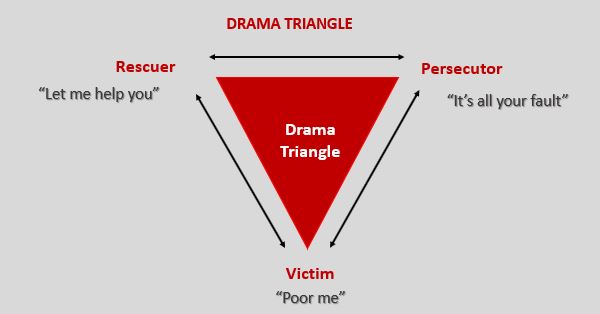Building on our theme from two weeks ago that rescuing others is not really helping them (Rescuing is Not Helping), this week we take a quick look at the Karpman Drama Triangle in the workplace, developed by psychologist Stephen Karpman. This model provides insight into the dynamics of dysfunctional relationships and toxic interactions.
What is the Karpman Drama Triangle in the workplace?
The Drama Triangle illustrates three common roles that appear in unhealthy interactions at work and at home. The triangle consists of the victim, the persecutor, and the rescuer. People can get caught in a cycle of negative emotions, blame, and power struggles.
The three roles in the Drama Triangle
Victim
The victim often feels helpless, powerless, and hopeless. They may adopt a passive role and avoid taking responsibility for their actions, believing they do not have the power to change their circumstances.
Rescuer
The rescuer intends to help the victim, so they step in with quick solutions. This enables the victim’s behavior and builds dependency. Rescuers inevitably over-commit and do not look after their own needs first, so they may become overwhelmed and burned out.
Persecutor
The persecutor adopts an aggressive stance, blaming the victim and criticizing the rescuer without offering helpful guidance.
How the roles shift
Roles are not always static. Players can change roles, and if one person switches roles the others will often change to counterbalance. The pattern can cycle in a single meeting, across a project, or through a whole relationship.
When the triangle shows up at work
The Drama Triangle appears in team conflict, stakeholder negotiations, and manager, employee discussions. In the short term, tension can surface real issues and lead to constructive conflict. Over the long term, if the relationships become detrimental to one or more participants, steps should be taken to break the triangle.
Breaking the Drama Triangle at work
Self-awareness is the first step. Understand the role you are playing, then adjust your behavior to change the dynamics. You can begin with small, consistent shifts.
- Pause and name it. Notice when you feel pulled into victim, rescuer, or persecutor energy.
- Own your choices. Replace blame with clear requests and agreed boundaries.
- Stop rescuing. Ask what support is needed, and what the other person will do next.
- Be specific. Give actionable feedback rather than criticism.
- Refocus on outcomes. Align on the shared goal and next steps.
Communicate with the other participants and take active steps to break the negative cycle.
What comes next: The Empowerment Dynamic
Next week we will explore how the Drama Triangle can be replaced by Womeldorff’s (Emerald’s) The Empowerment Dynamic, which offers a more empowering and positive approach to these roles.
Support for leaders and teams
If you want support to shift your team from the Drama Triangle to healthier dynamics, Sage and Summit offers leadership coaching, executive coaching, and team workshops.
Sources:
https://www.forbes.com/sites/remyblumenfeld/2018/12/07/how-to-transform-your-relationships-by-getting-creative/?sh=7638915a7565
https://leadershiptribe.com/blog/the-drama-triangle-explained
https://karpmandramatriangle.com/




